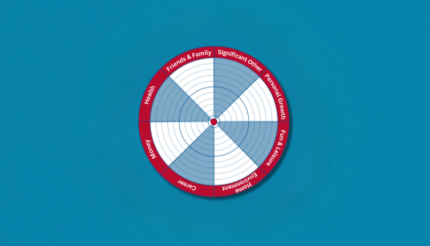When you set goals, keep this idea in mind: effective goals generate growth.
As you sit and write down your goals, think about what you want to achieve, and how you can grow whilst moving towards your objectives. If your plans don’t scare you a little, they’re simply not big enough! Let’s take a closer look at goal-setting and how it can change your life.
Why Setting Goals Matters
Goals are an essential element in the formula for life success:
Dreams x Goals x Learning x Planning x Action = Success
Setting goals can help you in two significant ways:
- Goals give you direction and a destination. You have somewhere to go, and you know the path to get there.
- Goals give you momentum. Having something to work towards keeps you moving, and the fact that you are being pro-active can open up new opportunities in your life.
However, not all goals are good goals. To benefit from them the most, you need to make sure that they reflect who you are and what you want out of life. Be true to yourself; don’t set a goal just because someone else says you should.
Stay clear and focused on what you want to be, what you want to do, what you want to achieve. Choose only what you feel passionate about, what gets you excited and what makes you feel motivated.
Be sure to plan for all areas of your life. If you only have business goals, and focus exclusively on those, the other areas of your life may get forgotten.
A Word on SMART Goals
Effective goals are SMART goals:
Specific — Making more money or losing some weight is not a goal. Be specific about what you want to achieve.
Measurable — Ensure the goal is quantifiable, to make it easier to track your progress.
Achievable — Far-reaching goals are fantastic, but you should still break down each goal into milestones that are attainable. If you put down something that is too far off, the time taken to get there may demotivate you, instead of pushing you to do the work.
Result-oriented — A goal is about achieving something. For example, writing content isn’t necessarily a goal (unless this is your job). Getting 10,000 website visitors reading your content is the kind of result you want to focus on – aim for something tangible
Timely — Put a time frame to every goal in your list: “I want to achieve specific result by specific date”.
The Three Levels of Goals
Brad Sugars, Chairman and Founder of ActionCOACH, divides goals into three levels.
Level 1: Away Goals
‘Away Goals’ are goals that are phrased as a negative and you are meant to get as far away as you can from the negative, eg: “I don’t want to work 80 hours a week” or “I don’t want to be overweight anymore.”
The downside of having away goals is that you can end up focusing on the negative part. As a consequence, you might end up doing what you were trying to avoid! Moreover, if you reach your goal, you may slow down or stop, and it could actually cause a backwards step.
Level 2: Towards Goals
‘Towards Goals’ are meant to push you forward to reach a positive outcome. They should excite you and scare you in equal measure! If you set big goals, they can be more powerful than the Level 1 goals, as they motivate you to keep moving and to achieve more.
The secret with Level 2 goals is that you must keep visualising the potential end results in order to stay motivated. With negative goals, the effects of not doing the work are always there, pushing you to take action. With positive goals, you must remind yourself constantly why you are doing what you do.
Level 3: Legacy Goals
‘Legacy Goals’ bring into your life something bigger than yourself, bigger than just your personal aspirations. For this level, you have purposes like providing for your children or leaving something behind. To set legacy goals, you must answer the question, “What do you want your life to be about or to stand for?”
Brad Sugars suggests writing your obituary as an exercise to understand what you want in life and to define your legacy goals. Use your imagination to create different realities, and the exercise can change the way you see your life and set your long-term goals. While doing the exercise, think about the people you want to impact with your actions, and how you want them to see you. It can change what you want to be and what you wish to achieve.
The Four Lessons of Goal Setting
1) Set goals you can grow into.
Growth has to be part of your journey. When setting goals, don’t consider only your current knowledge and skills. Goals must encourage you to learn. If you are not growing to achieve the goal, it is not the right goal for you.
Set goals based on the person you’re becoming, and the person you wish to become; this way, you make it easier for yourself to grow and to make your dreams a reality. It can be scary to write down a dream or goal when you don’t know when it will happen. But fear and excitement are signs that your goals are big enough to help you grow.
If you are not sure how to set such goals, sit down and make a big list of the things you know you don’t want. Then, flip the list, and translate the Away Goals into what you do want to happen.
2) Start doing new things every day.
Set goals so that you can try new things and aim to do something different each day. A big part of success can be doing new stuff or finding new ways to do something. If you don’t change anything about the way you work, nothing will change in your results.
Pay attention to how well you make time for new things in your daily tasks, to stay away from “shiny object syndrome”! Do new things every day, but don’t jump from one thing to the next. Focus on your goals for the time frame you’ve set.
If you are always chasing new things, it means you haven’t set realistic goals and don’t have clarity regarding what you want to achieve. People often underestimate what they can do in 10 years but overestimate what can be done in 1 year! If you have a great idea but it distracts you from your current goals, save it for the next quarter or next year.
Setting goals keeps you on track. Write down your goals and put them on the wall to go over them daily or weekly. It will help you stop gravitating towards shiny objects!
3) Don’t change the goal: change the strategy.
If things don’t go as planned right from the start, you may feel tempted to change your goals. Keep the goal but change what you’re doing. Go after what you want with a significant push and remember that major goals require meaningful actions and shifts.
4) Aim for harmony, not balance.
The most outstanding achievers often don’t have ‘balance’. They may have been way out of balance while working to achieve their goals. You don’t want to be out of balance forever, but in the short term an imbalance is fine if it is going to help you achieve what you want.
Try to aim for harmony in your life instead of balance. When you work to create the life that you want, things don’t have to be perfect. They need to make you happy and enable you to live a fulfilling life.
What’s Next?
Let’s recap what growing into your goals is all about:
- Goals must be your goals, not someone else’s. Go for the things that will make you happy, not to please others.
- Stay on track. Always move with momentum in all areas of your life. Write down your goals, including legacy goals, so that you can read them and visualise achieving them each day.
With this in mind, start writing down your positive goals (Towards Goals). Also, do the exercise of writing your obituary to help you identify your Legacy Goals.
Review your goals and answer the following questions:
- What are the areas of your life where you don’t have any goals?
- How many Away Goals and how many Towards Goals do you have?
Write down daily goals: what do you want to achieve tomorrow? Then move to weekly, monthly, quarterly and annual goals, so that you end up planning for the following 3 to 5 years.
Learn to get better at your daily goals, and you will soon find that the weekly goals become easier to achieve. When you master weekly goals, you’ll find the same with monthly goals, and so on.
And it all starts with writing things down: put pen to paper to make your goals real.





